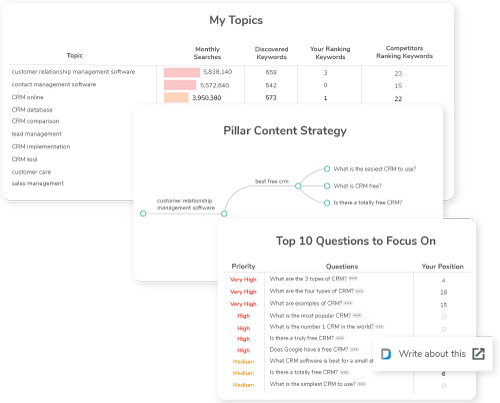How Many Times Should a Keyword Appear on a Page?
January 3, 2022 •DJ Team

Consumers use keywords to find what they’re looking for online. Businesses use keywords to indicate what they provide. As such, keywords are the connecting points between the content you write and what audiences intend to explore or buy.
And even when used to improve SEO, keywords still act as the primary tool to make content more relevant… which grows ranking and traffic… which connects us with an audience.
But once you’ve done your SEO keyword research to find a list of valuable SEO keywords that will help drive traffic to your content, how do you use them strategically?
More specifically, how often should keywords appear in your content to have SEO effectiveness without compromising the integrity of the content in a way that would hurt ranking? We’re exploring this particular aspect of SEO keyword strategy below.
How Many Times Should a Keyword Appear on a Page?
Before attempting to standardize your content with a hard, fast rule for keyword repetition, consider the purpose of keywords, the importance of organic content, and the direction of SEO.
Follow the trajectory of search engine algorithm evolution, and you’ll see a pattern that trends towards user-friendly, organic content. In other words, if you stuff your content full of keywords to the point where the content is unreadable, it’s not going to work. So that should be the first question you ask about keyword frequency: What fits the content?
A keyword appearing once every 200 words seems to be a close approximation and a good rule of thumb. But that, too, depends on the article or blog. Instead, aim for both placement and relevancy. Your keyword should appear in the title, subheaders, body copy, and potentially in the alt text of the featured image.
How Many Keywords Should You Have on a Page?
Similar to keywords frequency, the number of keywords you use on a page should first be dictated by the content. Sometimes, the longer the content, the more keywords you can attempt to include. But, at a certain point, you’re better off creating additional pages for other variations of your primary keyword. Remember, all your content doesn’t need to be on one page. In fact, it probably shouldn't be.

(DemandJump's keyword research tool shows you the exact content to write and provides one-click SEO content briefs.)
Typically, content is most effective when you start with one primary keyword, and it will often appear in your title. This primary keyword will help you determine a more developed keyword list, including variations on your primary keyword, which you should also include in your content. How long should your list be? Well, that depends upon the length of your content. For a blog, you might aim for 5-10 keywords and phrases, for example.
Does Repeating Keywords Help SEO?
The ideal number of keywords for SEO is more about placement than the number of times a keyword is repeated. A typical strategy is to include a keyword once or twice in the text of your content—either in the title, in headers, or in the body. Anything more than this could be a symptom of keyword stuffing or a lack of meaningful content.
You want to get your keywords in front of your audience. But the fact is that including them a bunch of times won’t work any better than only including them once or twice. You’re much better off including a list of keywords once or twice than jamming in the same keyword several times.
What Is Keyword Stuffing?
At some point, you’ve likely come across a piece of content that was obviously keyword stuffed. The keyword appeared in nearly every sentence, was often misused in the sentence structure, and distracted from the message. In fact, the repetition of the keyword made the content unreadable.
Or maybe the questionable content you’ve detected was more discrete: a word that appeared frequently, and in places where it didn’t quite fit.
This is all keyword stuffing. When a piece of copy is force-fed one or two SEO keywords in an effort to drive it to the top of a search engine’s rankings. This tactic occurred more often when search engine algorithms were still juvenile in development, but unfortunately, it still occurs today.
Avoid this by returning to our golden rule of keyword-driven content: The readability and relevance of the content should dictate the keyword placement.
Find The Right Keywords with DemandJump
DemandJump helps its customers develop complete keyword strategies that find the sweet spot between SEO relevance and the organic content users value.
![]()
With data-driven solutions, our platform can track keyword relevance with customers and identify patterns and information that can inform your marketing team on best keyword practices and approaches.
Get started creating content that ranks - today!
Featured Articles
Categories
- Attribution Tracking (13)
- Channel Optimization (11)
- Consumer Insights (68)
- Content Marketing (251)
- Data Science (8)
- Digital Marketing (6)
- Digital Transformation (26)
- Enterprise (10)
- Lead Generation (14)
- Market Intelligence (8)
- Marketing Analytics (39)
- Marketing Attribution (57)
- Marketing Management (153)
- Marketing Operations (86)
- Organic Search (222)
- Paid Search (52)
- Pillar-Based Marketing (63)
- Programmatic Advertising (9)
- SaaS Content (14)
- SaaS Marketing (29)
- Search Marketing (111)
- SEO Keyword Research (28)
- SEO Pillar (18)
- SEO Strategy (46)
- SMB (5)
- Website Content (12)


